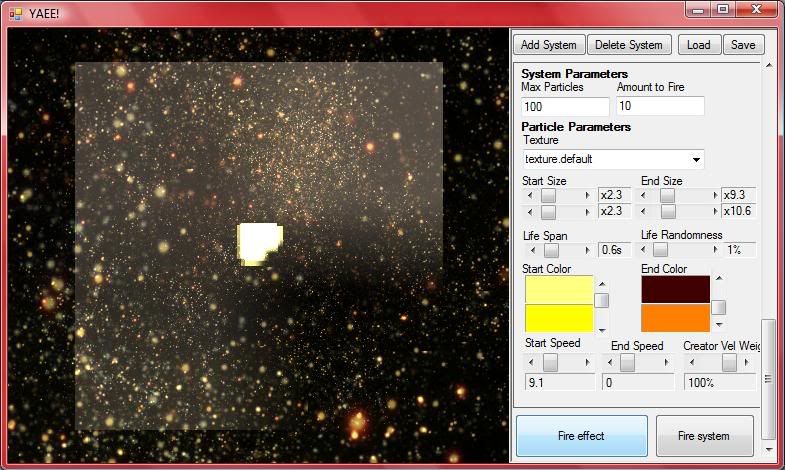It's been another long hiatus since my last entry where I discussed a bunch of semi-boring crap about how stuff gets loaded in Space Combat Sim. Last week (that is the week ending on the 13th) I worked out the protocol for sending the initial game state from one player to another. That part is running somewhat nicely though I've got a bunch of other broken crap to fix before I can really give the details of what I'm doing.
This week, as you may guess, I'm going to talk about particle effects! Yay! Celebration!!! Peanut butter!
Ahem. Last part I discussed some basic theory on particle effects and had a pretty screenshot from an old project. Now I was hoping to talk about a clever method I had devised for making really versatile effects with relatively little shader code and some HLSL snippets. The idea was to store positional, colour and scaling data in the form of textures. Unfortunately this method turned out to be less than workable.
The idea originated when I was mulling over using cubics, or higher order functions to define the movement and other functions for particles. I figured this would result in a great deal of operations since the function would have to be completely integrated every time a particle gets rendered. At some point I began thinking about such functions in relation to producing complex colour gradients that the particles would run through as they did their thing. I got the idea that if I used a texture I could get a great deal of versatility. By using one texture co-ordinate to represent time and using a random value for the second I could have a particle effect with tens or hundreds of subtly different colour gradients with the hardware doing all of the hard interpolation work practically for free.
After a little more thought I figured this could be applied to particle positioning. Much in the way a normal map texture's colours represent vectors instead of actual colours I could have a texture whose colours represent a position in space. Depending on implementation this might add expense in the form of providing a normal, tangent and binormal to individual points sprites. Lots of floats but makes for very simple math in aiming a particle effect in a particular direction.
So, where did this go wrong? A few places. The first, and biggest, was that doing texture lookups in the vertex shader (which is where effects are applied to points sent to the graphics hardware) is apparently unsupported. If anyone knows a way of doing texture lookups in the vertex shader PLEASE TELL ME. This wasn't enough to prevent me from using the texture to provide fancy colour gradients however. Instead of looking up the colour in the vertex shader I'd simply pass the co-ordinates (time, and a random value) on to the pixel shader. So, it's not a complete loss.
I have yet to implement the gradient texture due to some stupidity on my part (I used a texture co-ordinate at first which the hardware happily interpolated for me utterly destroying my lookup values.) I can probably salvage it by passing the lookup in a colour semantic since those aren't interpolated. For now I am lerping between a randomly selected starting and ending colour.
What I have now is basically a stripped down version of Microsoft's Particle3D sample which I'm mutating into a setup that meets my needs. I'll leave you with a screenshot of my particle effect editor tool to finish.


No comments:
Post a Comment